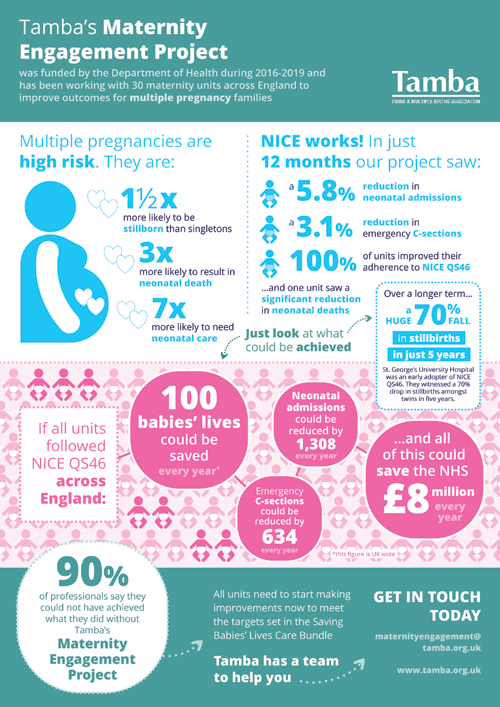Tamba’s Maternity Engagement Project supports positive outcomes
Tamba’s (Twins and Multiple Births Association) Maternity Engagement Project is a world-first pioneering project that could save babies’ lives and millions of pounds for the NHS. If all maternity units in England followed the project and implemented similar changes, within a year neonatal admissions in multiples could be reduced by 1,308, emergency c-sections could be reduced by 634 and the NHS would save £8 million through reduced neonatal admissions. Furthermore after five years, up to 100 stillbirths could be prevented each year across the UK.
Keith ReedCEO of Tamba
Tamba’s (Twins and Multiple Births Association) Maternity Engagement Project is a world-first pioneering project that could save babies’ lives and £8 million a year for the NHS. The project has been praised by obstetricians, midwives, sonographers, parents and also by Baroness Cumberlege, who led a major review of maternity services.
Tamba’s project implementations yielded fewer neonatal admissions and fewer emergency caesarean sections over a 12-month period. If all maternity units in England followed the project and implemented similar changes, it is hoped that within a year:
- neonatal admissions in multiples could be reduced by 1,308
- emergency caesarean sections could be reduced by 634
- the NHS would save £8 million through reduced neonatal admissions.
Furthermore after five years up to 100 stillbirths could be prevented each year across the UK (FIGURE 1).1

FIGURE 1 Tamba’s Maternity Engagement Project.
Background to the Maternity Engagement Project
In 2013 NICE (National Institute for Health and Care Excellence) published Quality Standard 46,2 which contains eight statements aimed at improving the quality and consistency of clinical antenatal care provided for multiple pregnancies. However, research by Tamba showed that expectant mums of twins or more were being treated differently at maternity units across the country.
The charity was already working closely with the team at St George’s Hospital in London on other research projects and was monitoring its early adherence to NICE QS46, which after a few years had produced excellent results. It was because of the encouraging results from St George’s, and Tamba’s knowledge that care differed throughout the country, that the Maternity Engagement Project was born.
Funded by the Department of Health and Social Care, the project worked with 30 maternity units across England to ensure women expecting twins, triplets or more were treated in line with the NICE multiple pregnancy guidance.
Latest data1 show that multiples are still more than one and a half times more likely to end in a stillbirth and over three times more likely to end with a neonatal death. Previous publications highlight that they are still six times more likely to result in a brain injury and contribute towards 10% of clinical negligence claims.
Audits and implementation
Throughout Tamba’s three-year project, specialist multiple midwives and Tamba staff supported NHS staff to implement the NICE guidance. Units were audited and then revisited 12 months later to assess the changes made and their impact. During the 12 months they also had regular check-in calls with the specialist midwives to discuss progress and any issues and also had access to a wide range of Tamba resources.
Findings
The final report, which can be viewed on Tamba’s website (www.tamba.org.uk), shows that in just 12 months there were 200 fewer neonatal admissions and 105 fewer emergency c-sections. It also reveals 40 ‘statistically significant’ positive findings that clearly demonstrate the successful approach of the NICE guidelines and Tamba’s support throughout the process. Every unit that engaged with Tamba increased its overall adherence to NICE QS46 and the ones that made the biggest changes saw the best improvements.
Chair of the project, Dr Asma Khalil, Professor of Obstetrics and Maternal-Fetal Medicine at St George’s University Hospital, says: “If we are to successfully implement NICE guidelines, dedicated efforts are needed to overcome the barriers, such as raising awareness, updating knowledge, educating healthcare professionals and ensuring that the required resources are available in all maternity hospitals to provide a consistent high quality service.
“We should strive to reduce stillbirth in multiple pregnancies to levels similar to or even lower than singletons.”
Transparency – independent audit and evaluation
The Maternity Engagement Project also participated in an independent evaluation and all statistics were verified by an independent third party to ensure complete transparency. The evaluation revealed that 90% of respondents involved agreed with the statement: “If we hadn’t done the Maternity Engagement Project we would not have achieved as much positive change.”
The evaluation showed 81% confirmed continuity of care for women expecting multiples had improved and 69% said team-working between obstetricians, midwives and sonographers had improved – both key priorities identified in Better Births3 and NHS England’s Maternity Transformation Programme.4
Three-quarters of the units involved agreed that the Maternity Engagement Project was the catalyst for positive change in care for women expecting multiples and that the understanding of what is required to deliver the best possible care to multiple pregnancy families had improved.
One midwife involved in the project says: “Because the audit was so positive, news travelled to senior management. They were dumbfounded we had done so well in a service where we hadn’t put any additional resources. I finally found people were listening; [care for multiples] wasn’t just another specialty in midwifery. People finally sat up and listened.”
Another says: “The project helped to identify the gaps – that was really valuable. Nothing was provided for these high-risk women who end up in hospital. We were providing lots of things for lots of other high-risk pregnancies but not for these poor women. When we said that, it was an eye opener.”
Multiple pregnancy care pathway tool
As part of the project Tamba created a pregnancy care pathway tool that supports healthcare professionals to meet specific aspects of the multiple birth NICE guidelines. The proforma created as part of this, which has been endorsed by NICE, should be used throughout a multiple birth pregnancy. According to Mr Richard Smith, Consultant at Norfolk and Norwich University Hospitals Trust, Tamba was able to encourage his unit to develop its own care plan. He says: “Beforehand the approach was not always consistent across members of the team, with notes being written freehand rather than in a template. Tamba helped us focus our efforts. The fact that we were being audited again in 12 months time gave us some specific targets to work towards. The proforma care plan provides a consistent approach.”

Gracie and Olivia Trede, born at 29 weeks’ gestation and in neonatal care for six weeks.
Case studies
One case study where the project improved safety involved a patient with a pregnancy recorded as dichorionic at booking. Complications arose that were suggestive of a monochorionic pregnancy. The team was able to look back at the scan image, which the sonography team had been attaching to the record since Tamba’s visit. This allowed them to reclassify the pregnancy as monochorionic and manage the pregnancy appropriately, with a good outcome.
Other units introduced or tightened their specialist multiples clinics and at Basildon and Thurrock University Hospitals NHS Foundation Trust the benefits of a dedicated multiples clinic with a specialist midwife and deputy, and a specialist obstetrician are being seen. Advanced Specialist Audit and Research Midwife Donna Southam says: “It feels like a team, they work well together. It’s co-ordinated. The midwife can bring forward appointments with the consultant if she has any concerns. Women have fewer, more streamlined appointments and a named contact. It’s good for continuity of care.”
She also praised Tamba’s approach, saying: “It’s a low-cost intervention that leads to a smarter way of working.”
Recognition
There was further recognition for the project from a top UK professor with special clinical expertise in twins and higher order pregnancies. Writing in BJOG: An International Journal of Obstetrics and Gynaecology,5 Professor Mark Kilby of the University of Birmingham’s Institute of Metabolism and Systems Research and author of national twin guidelines says pioneering programmes aimed at saving the lives of babies from multiple pregnancies need to continue. He said the introduction and clinical uptake of evidence-based guidance from NICE QS46, as advised by Tamba in its Maternity Engagement Project and the Royal College of Obstetricians and Gynaecologists’ (RCOG) ‘Green Top’ guidance, on the management of monochorionic twin pregnancies is almost certainly improving care, thus reducing mortality rates in multiple pregnancies.
What next?
Tamba’s Maternity Engagement Project has shown that in the best case, after five years the lives of up to 100 stillborn babies could be saved every year if all maternity units across the UK follow NICE QS46. This would result in a twin stillbirth rate of 1.85 per thousand, which is below the 2016 singleton stillbirth rate of 3.86.6 Evidence from The Netherlands shows that it is possible to reduce the twin stillbirth rate to a rate lower than the singleton rate.
Taking into account the requirements in the Saving Babies’ Lives Care Bundle,7 which aims to cut stillbirths by 50% by 2025 and now includes specific references to multiple births, it is even more important to follow the NICE guidance in order for the Government to achieve its ambition. This is especially true as the Saving Babies’ Lives Care Bundle has now been included as a requirement of the NHS Standard Contract 2019/20. We know, and now have the evidence to prove, that following NICE guidance on multiple pregnancies works. Tamba urges the NHS to ensure local maternity teams are aware that this project can make a considerable contribution to meeting the Government’s ambition to reduce stillbirths, neonatal deaths and preterm births. Evidence shows that while units know they should follow this guidance, they often find it difficult and can face barriers without a third party assisting.
As an independent third party with multiple specialist midwives, staff at the units Tamba worked with were keen to become involved, and the results speak for themselves. Tamba can support these positive outcomes.
If you would like to know more about the project or require help making changes in your unit, please email the Maternity Engagement team: maternityengagement@tamba.org.uk
Or read this article in our
Tablet/iPad edition


